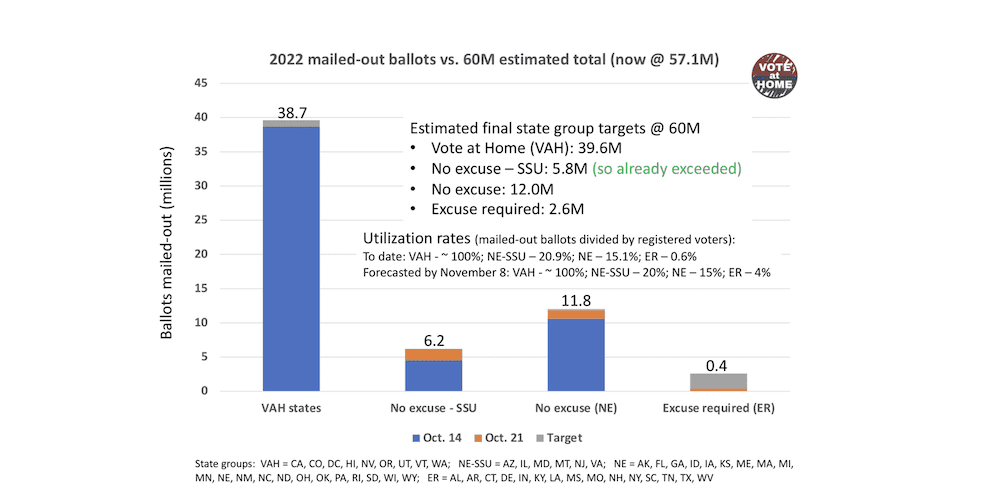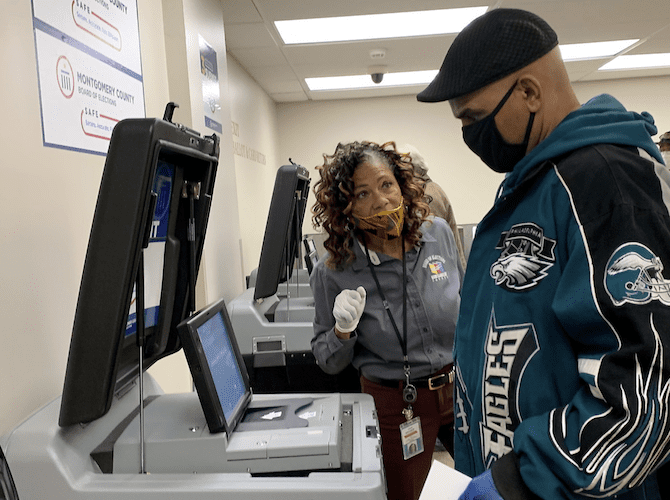A Third of Midterm Voters May Use Mailed-Out Ballots

(Estimated 2022 vote at home totals. Graph via voteathome.org)
Despite both a torrent of lawsuits attacking every aspect of voting with mailed-out ballots in the 2020 presidential election as well as post-election efforts in GOP-led states to pass laws limiting their use, a record-setting 42 million or more Americans are likely to vote using mailed-out ballots in the 2022 general election—a 40 percent increase from the last midterm election in 2018.
One of the largest contributing factors to the expected increase in mailed-out ballot voting in the 2022 elections is that a few states, led by California, will mail every voter a ballot after temporarily expanding that voting option during the 2020 presidential election in response to the COVID-19 pandemic. But another notable cause of the increase is that several battleground states that expanded access to mailed-out ballots in 2020 will also see growing slices of their electorate vote this way in 2022, according to election analysts and campaign data brokers tracking voters this fall.
Those battleground states include Florida, Michigan, Pennsylvania, and Wisconsin, where the volume of requests by voters for mailed-out ballots is significantly greater than during the last midterm election in 2018.
As of October 13, Florida had 1.3 million more requests for mailed-out ballots for the 2022 election than in all of 2018, according to the National Vote at Home Institute (NVAHI), a nonprofit that promotes this manner of voting and has been tracking its likely use. Michigan had 775,000 more requests in 2022 compared to 2018, Pennsylvania had 1.1 million more, and Wisconsin had 300,000 more.
Nevada, whose U.S. Senate contest is among a handful of races that could decide that body’s majority, also will be mailing every voter a ballot this fall.
“I think it is just people getting comfortable with mailed-out ballots because of the pandemic,” said Gerry Langeler, NVAHI research director.
On the other hand, a few GOP-led states that Donald Trump won in 2020—and where he and his allies attacked this means of voting in court and in the media—are seeing the number of requests for mailed-out ballots in 2022 remain similar or decrease as compared to 2018, according to data collected by NVAHI and Catalist, a campaign data broker serving Democratic candidates.
As of October 13, “26 days from Election Day,” Catalist reported that Arizona and Ohio had comparable numbers of requests for mailed-out ballots to four years ago. The number of requests for mailed-out ballots in Iowa and North Carolina, with competitive U.S. Senate races, had dropped significantly compared to 2018. (Some of this shortfall may be delays in reporting to state officials and brokers, Langeler said.)
Thirty-Five Percent of Midterm Voters?
Broadly speaking, voters have three options to cast ballots: in person before Election Day, in person on Election Day, and using a mailed-out ballot before or on Election Day. Each option has different requirements for the voter before they have a ballot in their hands. (With mailed-out ballots, some states will send every voter a ballot, other states send voters an application before they are sent a mailed-out ballot, and other states require voters to apply on their own and meet specific qualifications.) In general, GOP-led states have more rigorous protocols, although there are some exceptions. Utah mails all registered voters a ballot, for example, which is the same as California and Vermont.
In the 2020 presidential election, a record-setting 65.6 million people voted with mailed-out ballots. Another 35.8 million people voted in person before Election Day, according to the U.S. Elections Project, led by University of Florida professor of political science Michael P. McDonald, one of the nation’s foremost voter turnout experts.
Historically, turnout in midterm elections has been a third or more lower than in presidential elections. But even with an overall lower turnout, the most recent data shows a shift toward mailed-out ballots. Compared to the 2018 midterm elections, when 42.2 million ballots were mailed out and 30.4 million voters used them—resulting in a 71 percent turnout—nearly 54 million ballots have been sent out by mid-October 2022, more than three weeks before 2022’s Election Day.
“As of October 14, 2022, NVAHI estimates that about 18 million more ballots will be mailed out in 2022, compared to 2018—60 million versus 42 million—and that if historic return rates apply, at least 12 million more ballots will be returned (42 million versus 30 million),” a memo from NVAHI said, basing its prediction on 2018’s 71 percent return rate. “If the 2022 turnout rate matches 2018, that will equate to about 118 million votes cast, so mailed-out ballots will account for 35 percent.”
As of October 21, Langeler said that 57.4 million ballots had been requested or mailed out.
“Many states where the voter must request a mailed-out ballot are not yet reporting their volume of requests,” an October 21 update from NVAHI noted. “So, the 2022 numbers will continue to grow over the next few weeks as more voters apply for mailed-out ballots.”
The growing embrace of voting from home is more remarkable because no other means of voting was attacked as vigorously by Trump-supporting Republicans in 2020, according to a detailed report by the Stanford-MIT Healthy Elections Project published in July 2021. It noted that every step of the process in this manner of voting was “the subject of over 260 pre-election lawsuits challenging how the procedures and rules of mail voting apply in the pandemic—an unprecedented volume of litigation on the topic.”
That litigation amplified attacks on mailed-out ballots by top Trump administration officials, such as his Attorney General Bill Barr. In 2022, the former attorney general told the House Select Committee to Investigate the January 6 Attack on the U.S. Capitol that Trump’s stolen election claims had been investigated by the FBI and were “bullshit.” But in late July 2020, then-Attorney General Barr told the House Judiciary Committee that it was “common sense” that foreign countries could corrupt U.S. election results by forging large quantities of mailed-out ballots.
That assertion, like virtually all of Trump’s voter fraud claims, was false, noted Michael P. McDonald in his new book, From Pandemic to Insurrection: Voting in the 2020 US Presidential Election. “It would be incredibly difficult for a foreign government to counterfeit mail ballots such that unwitting election officials counted them,” he wrote.
“A greater threat to mail ballot integrity is that some voters will attempt to cast a mail ballot, only to discover election officials rejected it,” McDonald continued, noting that upwards of 600,000 mailed-out ballots were rejected for a variety of technicalities (from improperly labeling and signing the ballot return envelope to signatures that didn’t match a voter’s registration form). “The minutiae of casting a mail ballot are many… please carefully follow all instructions!”
Still, the projected increase in mailed-out ballot use in the 2022 midterm elections will not be uniform nationally, but varies state-by-state and is dependent on each state’s laws.
In 2021, 14 states, mostly led by GOP majorities, rolled back or complicated some aspect of accessing a mailed-out ballot, according to the Brennan Center for Justice at New York University School of Law. (Those states were Alabama, Arizona, Arkansas, Florida, Georgia, Idaho, Indiana, Iowa, Kansas, Kentucky, Montana, New York, Oklahoma, and Texas.) In 2022, the Brennan Center reported that restrictive laws were passed in five states that will be in effect for the midterms. (Those states were Mississippi, Missouri, New Hampshire, Oklahoma, and South Carolina.)
However, in this same period, a greater number of states passed laws expanding access to mailed-out ballots—including California, Hawaii, Nevada, and Vermont, which adopted laws to institute all-mail voting, previously offered only in Colorado, Oregon, Utah, Washington, and the District of Columbia.
According to the Brennan Center, 16 states expanded or eased some aspect of accessing a mailed-out ballot in 2021. (Those states were California, Connecticut, Hawaii, Illinois, Indiana, Kentucky, Maine, Maryland, Massachusetts, Minnesota, Nevada, New York, North Dakota, Oregon, Vermont, and Virginia.) In 2022, the Brennan Center reported, six states passed laws expanding access that will be in effect for the 2022 midterms. (Those states were Arizona, Connecticut, Louisiana, Massachusetts, New York, and Rhode Island.)
While a handful of states passed laws that the Brennan Center characterized as “restrictive” and “expansive”—a sign that using mailed-out ballots in those states is highly regulated—the likely impact on the 2022 midterm elections is that a third or more of the nation’s voters will cast their votes via mailed-out ballots.
The development in the method of voter participation in which 42 million or more Americans are likely to vote from home is a paradigm shift among the electorate.






